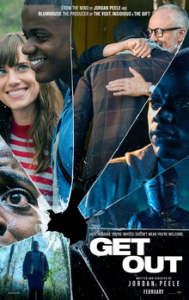film review: get out

Jordan Peele’s Get Out extraordinarily combines the horror genre with poignant social commentary, using satirical observations to show the racial divide within Western society. For his directorial debut, Peele achieved his goal of showing a ‘common humanity’ by dispelling usual movie tropes. The film tells the story of Chris (Daniel Kaluuya), a young black man who is meeting the parents of his white girlfriend Rose (Allison Williams) for the first time. By using Chris as the protagonist, and white suburbia as the antagonist, Peele invites the film’s audience to understand the ingrained biases faced by African Americans on an everyday basis.
The film opens to Childish Gambino’s song Redbone, chosen by Peele because he considered the ‘stay woke’ lyric an apt precursor for what comes next. The film expertly manages to base the film around Chris’ ability to survive not only a fictional horror story, but also everyday racism in a predominately white space. His survival fundamentally comes down to his awareness and ability to “stay woke” by building up defence mechanisms after a lifetime of micro-aggressions. The first main example of this is a scene in which a police officer asks for Chris’ license after Rose hits a deer while she’s driving. Chris, who smiles and accommodates the officer, shows how accustomed he is towards managing this daily bias. Meanwhile, Rose fiercely defends Chris and tells the officer ‘that’s bullshit’. Rose, born with class and white privilege, has no fear in questioning or defiantly speaking to the officer. With this scene, Peele illustrates different experiences of living, showing how Chris is consistently on edge in a society that is immediately biased towards him.
The development of Rose is arguably the most impactful parts of the film. Liberal, white viewers of the film might relate to Rose – she abhors racism, is aware of discrimination and stands up for Chris when she sees biases occurring. But the dramatic transformation of her character shows the way white liberals are complicit in racism. When she searched for the keys to Chris’ escape, it was tempting to think that maybe she was a victim herself, instead of a willing player in her parent’s plot. By twisting the white female saviour into the antagonist, Peele shows that racism happens everywhere, no matter the neighbourhood or how progressive it may seem. Rose’s lucidity in the process of tricking Chris cleverly serves to reiterate the level of dehumanisation continually facing African Americans, even from people who appear to understand their experiences.
This point is reinforced through the character of Jim Hudson, a white, blind art dealer who is an admirer of Chris’ photography. His inability to see Chris’ skin colour provides relief, and he becomes the only person Chris seems comfortable around throughout the ordeal of offensive racial comments by Rose’s extended family. This moment of trust is later shown to be another lie, with Jim winning an auction to buy Chris. When Chris has the opportunity to ask Jim ‘Why us? Why black people?’, Jim says he couldn’t care what race he is. ‘I want your eyes, man. I want those things you see through.’ As commented by The Atlantic, Jim serves as another reflection of well-meaning liberals and those who believe in a post-racial America, the type of person who ‘doesn’t “see race” while caring very little about the wellbeing of black Americans’. Jim wants to possess Chris’ ‘superior physical abilities’ and how he sees the world, while being completely ignorant to the complexities that come with being black.
Earlier in the film, Chris redirects a question about the African American experience to the hypnotised Logan (Lakeith Stanfield). Although he is forced to respond in an empathetic way to stop Chris from questioning who he really is, he can only come up with ‘I’ve found that the African American experience for me has been for the most part very good’. Peele uses this scene to cleverly reinforce that despite self-congratulatory progressive stances or raves about Obama, white liberals are often deeply ignorant and unwilling to genuinely understand racial inequalities.
The end of the film is deeply affecting, showing a police car arriving to Chris holding up his arms in submission and Rose pretending to be an innocently attacked white woman. Although his acts of violence arose from desperation and self-defence, the flash of police lights mixed with Rose’s cries make it clear that Chris will be immediately pinned as the villain due to the colour of his skin. While enabling the audience to realise common and sadly realistic injustices regarding police brutality, Peele subverts another trope by redirecting the scene and allowing Chris to complete the hero’s journey. After enough movies where the black characters are killed off, tortured or sacrificed, Peele manages to finish the film with a tint of triumph through Chris’ survival.
Get Out is a uniquely clever film that bravely approaches commonly subverted truths about discrimination and intersectionality. Impressively, it manages to do this by flipping common tropes while maintaining a captivating storyline. Combining horror and comedy, Get Out offers a thought-provoking critique of society, perhaps making some audience members question their own role in white hegemony.

